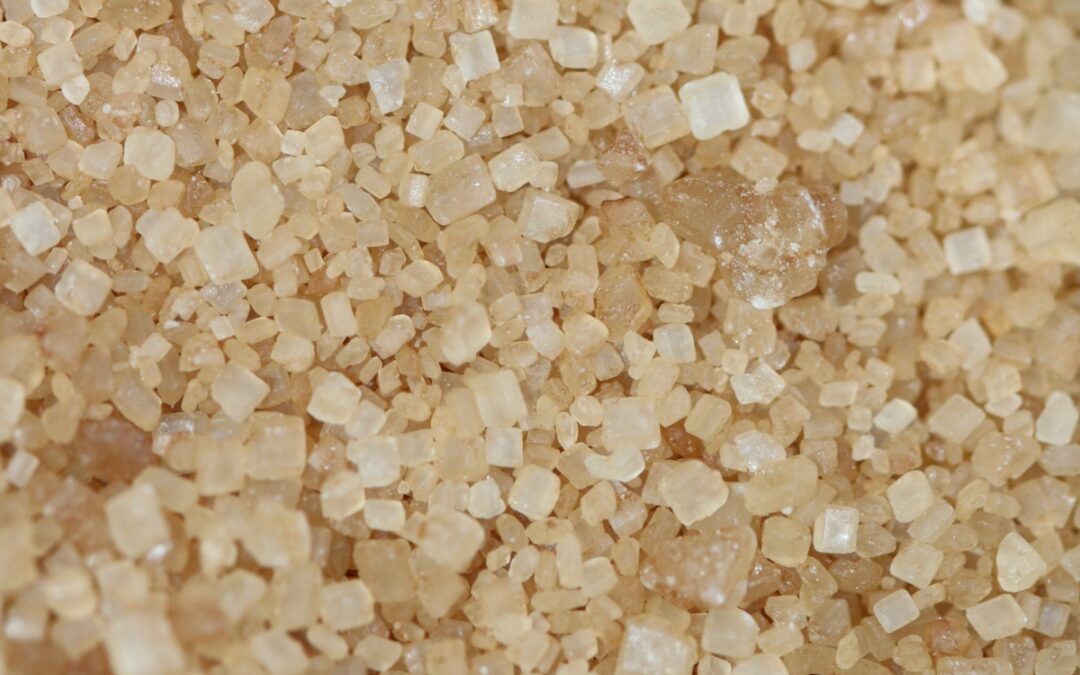You’re reading over a recipe, and it calls for light brown sugar… but you only have dark brown sugar. How much of a difference will that swap really make? Welcome to the third and final part of our blog series, This or That? How Ingredient Swaps Impact Your Recipes. In today’s blog, we’re discussing—you guessed it—sugars.
(In case you missed the previous articles in this series, be sure to check out Part 1: The Fats and Part 2: The Flours)
We’ve all had moments like the one above, where a recipe calls for light brown sugar and all you’ve got is dark. Or perhaps you’ve wanted to play around with sugar levels or types to change a recipe’s sweetness or complexity of flavor. Depending on what you’re making or what your goal is, it could be a simple swap or a complicated one.
Why Use Sugar?
 Obviously, sugar’s primary role is to add that sweet flavor we know and love. White sugar (granulated) is more of a straight sweet flavor, while darker sugars have hints of other flavors in them. Depending on the recipe, you might want the simple sweetness that comes from white sugar—or you might want a deeper, more complex sweetness like that of muscovado sugar.
Obviously, sugar’s primary role is to add that sweet flavor we know and love. White sugar (granulated) is more of a straight sweet flavor, while darker sugars have hints of other flavors in them. Depending on the recipe, you might want the simple sweetness that comes from white sugar—or you might want a deeper, more complex sweetness like that of muscovado sugar.
Like oil, sugar substitutions in recipes are common. There are several options, including everything from ripe bananas to honey. As with other substitutions, these can work well depending on the recipe, but you should always be prepared for changes in both the flavor and the texture.
When it comes to the amount of sugar, this is certainly something you can play around with as well—but one thing to keep in mind is sugar’s secondary function: caramelization and browning. If a recipe has more sugar in it, it will brown faster as it’s exposed to heat. If a recipe has less sugar, it will brown more slowly—or perhaps not even at all. Either way, you’ll need to be extra cautious about over- or under-baking your recipe if you’ve added or removed sugar. Looks can be deceiving!
The Most Common Kinds of Sugar
Let’s take a look at some of the common sugars you’re most likely to encounter in a recipe—what they look like, taste like, and when they can be swapped out.
White Sugar
White sugar—also known as refined, table, or granulated sugar—is highly refined sugar made from sugarcane and/or sugar beets. All naturally occurring molasses has been removed from this sugar, which is why it has that straight sugar-sweet flavor with none of the caramel flavor some other sugars give. White sugar is the most common type of sugar used in baking and is very versatile. You’ll find it in recipes for cakes, cookies, muffins, scones… you name it!
Caster Sugar
Caster sugar is like white sugar, but it has been ground into smaller crystals, which helps it dissolve faster in baked goods and liquids. You might also hear it referred to as superfine sugar, bar sugar, or ultrafine sugar. Caster sugar has the smallest crystals of any granulated sugar, making it great for use in delicate desserts like meringue, mousse, and pudding. It’s also ideal for making syrups, cocktails, or sweetening drinks.
Want to make some at home? No problem. Just toss some white sugar into the food processor and pulse until you’ve got super fine granules. Just be careful not to over-process it or you’ll end up with powdered sugar instead!
Powdered Sugar
Powdered sugar is known by many names, including confectioner’s sugar, icing sugar, and 10x sugar. But they’re all the same thing: granulated white sugar that has been ground into a fine powder. Typically, powdered sugar also has a small amount of cornstarch in it to prevent clumping and add stabilization properties. (Organic powdered sugar uses tapioca starch instead, and while the flavor and thickening properties of organic powdered sugar tend to be better, you’ll pay a much high price for it and will have to sift before every use to avoid lumps.)
Due to its powdery form, powdered sugar dissolves quickly in liquids, making it the perfect choice for icings, frostings, fillings, and decoration. Plus, the stabilization properties (from the added starch) make it a great choice for sweetening whipped cream.
If you’d like to make powdered sugar at home, mix one cup of white sugar with one tablespoon of cornstarch (or tapioca starch) in a food processor until you have a fine powder.
Pearl Sugar
At the opposite end of the fineness spectrum from powdered sugar is pearl sugar. Also known as nib sugar or hail sugar, pearl sugar is white sugar that has been compressed in to small, hard pearls. It is opaque in color and doesn’t melt when exposed to high temperatures due to its density. It is frequently used in Scandinavian baking and is great for decorating pastries, cookies, and buns since it will hold its shape through baking. Ever had a liege waffle? If so, you’ve had pearl sugar.
Crystal Sugar
Also known as coarse sugar, this sugar has large crystals that add lots of crunch to cookies and baked goods. It’s best used as decoration since it doesn’t melt down in heat like white or caster sugar. Here at Little Rae’s, we use crystal sugar to decorate cookies like our Autumn Leaves and Holiday Trees.
Sanding Sugar
A step down from crystal sugar is sanding sugar, which has medium-large crystals that are resistant to heat. Sanding sugar is most often used for decoration, and it adds a little crunch to cookies and baked goods (though not as much as crystal sugar). It also comes in a variety of colors to suit your decorating needs. We use sanding sugar to decorate our shortbread cookies that have more intricate designs, like our Unicorns, Mermaid Vibes, Angry Owls, and Squad Ghouls.
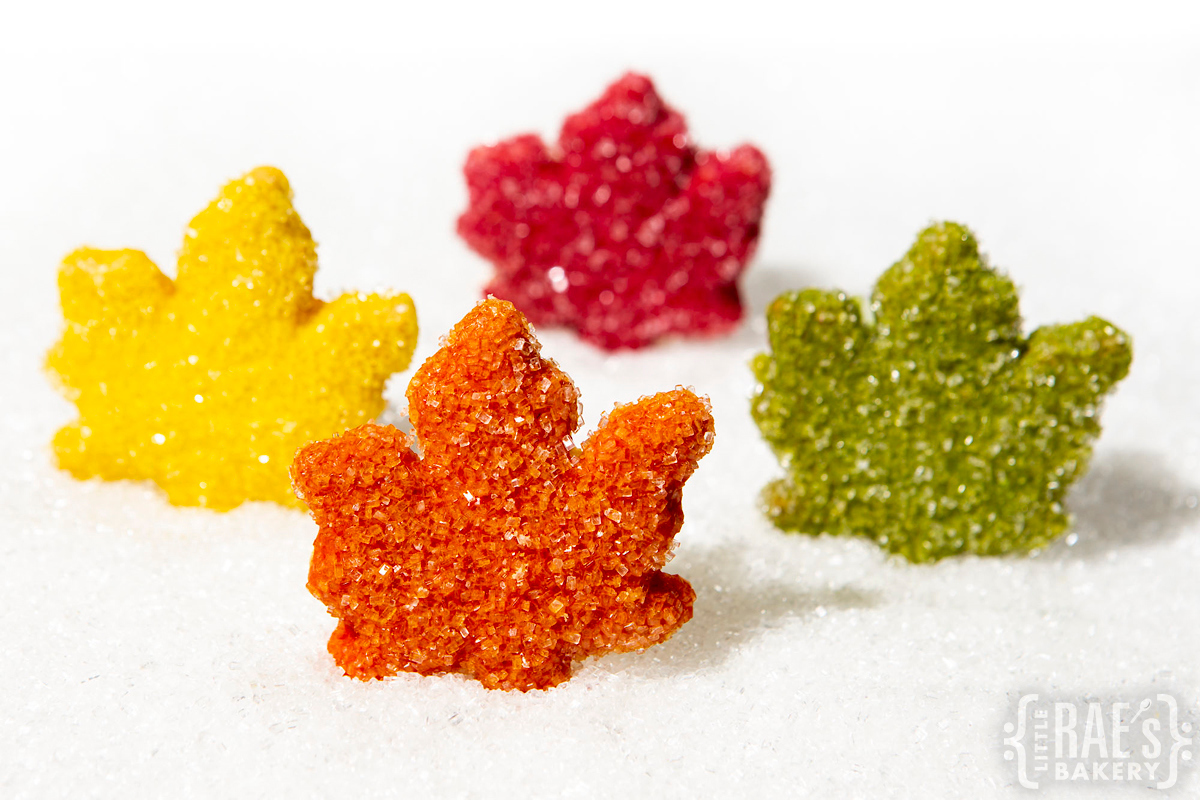
Coarse crystal sugar tops cookies like our Autumn Leaves, giving them lots of CRUNCH!
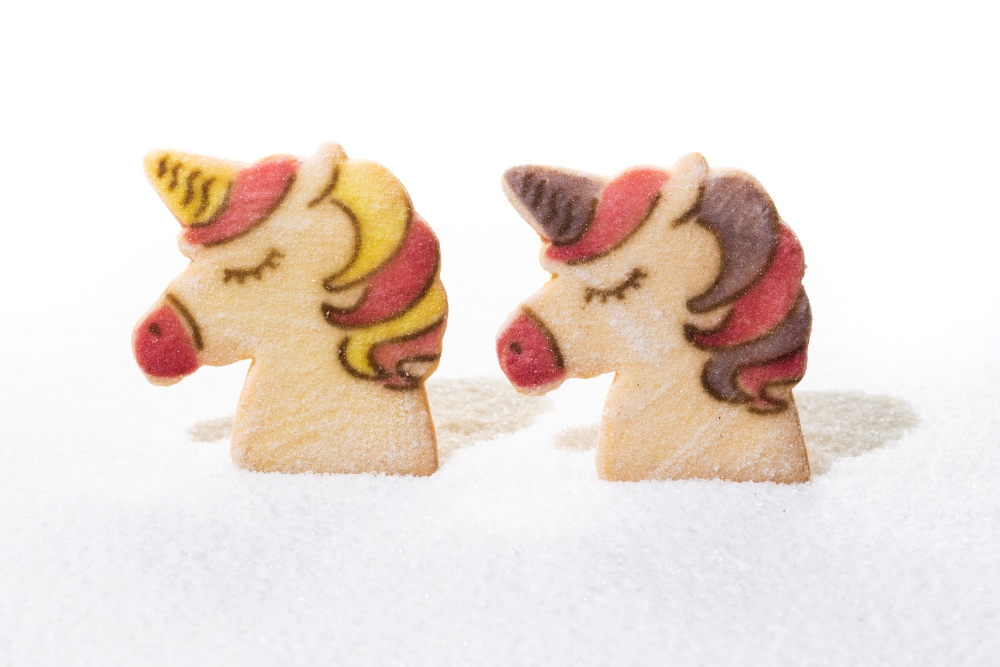
Finer sanding sugar adds sparkle to more intricate designs, like these Unicorn cookies.
Cane Sugar
Cane sugar is similar to white sugar and can be used in the same ways. It is made only from sugarcane—not sugarcane and sugar beets—and has been minimally processed. Due to this, it has slightly larger crystals and has a light caramel color. While it can be used interchangeably with white sugar, it comes with a higher price tag. We only use pure cane sugars in our products (no sugar beet sugar).
Our snickerdoodle cookies are made using pure cane sugar. For our much-loved ginger twinkle cookies, we use a combination of cane sugar and molasses for the dough, and then we roll them in sanding sugar for that extra “twinkle” on top.
Demerara Sugar
Demerara sugar is raw cane sugar that has been minimally refined—meaning that some naturally occurring molasses is still present. Demerara crystals are large and amber in color, and it has a light molasses or toffee flavor. It’s similar to turbinado sugar (below), but with less moisture and a lighter flavor. Demerara makes a lovely topping for baked goods of all varieties, and it’s also great as a coffee or tea sweetener (just be sure to stir well so that all the crystals dissolve). If you don’t have demerara sugar on hand, it can be swapped for dark brown sugar or turbinado sugar.
Turbinado Sugar
Another minimally refined raw cane sugar, turbinado sugar has only had its surface molasses washed off. It has a light caramel flavor and medium-brown crystals that are slightly smaller than demerara crystals. It’s lighter in flavor than demerara and brown sugar (below), but it could be used in place of them in a pinch. It also makes a suitable substitute for white sugar. Turbinado sugar works well in a variety of baking projects and as a beverage sweetener.
We’ve found turbinado to be a great sugar for decorating many of our products. Love our scones? The ones with sugar crystals on top use turbinado!

Our snickerdoodle cookies are made using pure cane sugar.
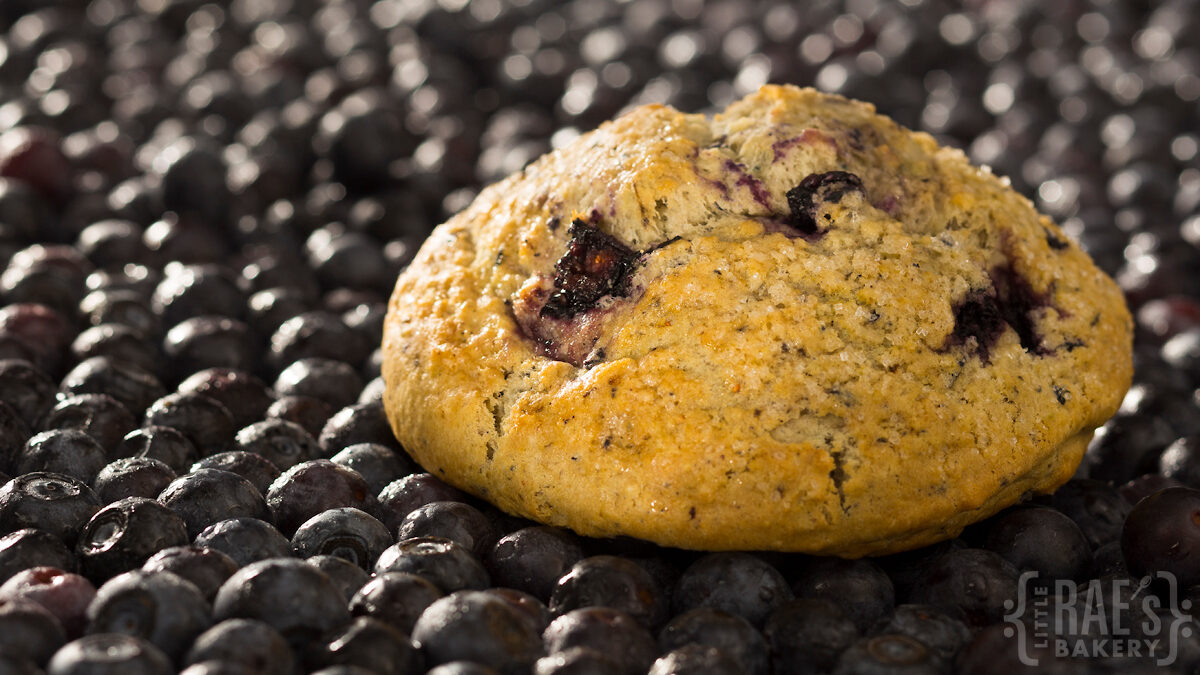
We use turbinado sugar as a topping for many of our scones.
Brown Sugar
Brown sugar is refined white sugar with a small amount of molasses added back in. It comes in light and dark varieties, the difference being—you guessed it—how much molasses was added. Because molasses adds moisture, brown sugar is wet and sandy in texture, which can add a lovely chewiness to baked goods like cookies. Just be sure to store it in an airtight container so that it doesn’t dry out and harden!
Brown sugar has a delicate caramel flavor (more so for the dark variety). Light and dark brown sugar can generally be used interchangeably, though you’ll likely notice a variation in how caramelly the recipe tastes. Brown sugar is great for all kinds of baked goods and savory dishes that would be complemented by a caramel flavor—just keep in mind that it does also add a small amount of moisture that could impact overall consistency. Brown sugar creates more caramelization and chewiness in high-sugar baked goods like cookies. We use brown sugar in our oatmeal cookies and both cane and brown sugar in our chocolate chip cookies for a more dynamic flavor and texture.
If you’re in the middle of a recipe and discover that you’re out of brown sugar, don’t panic—you might be able to make some yourself! Just add 1 pound of white sugar and 3 oz of molasses (by weight) to a food processer and mix until smooth and consistent in color.
Muscovado Sugar
Also known as Barbados sugar, muscovado sugar is dark, complex, and rich in flavor. Muscovado is unrefined cane sugar, meaning that the molasses has not been removed. The result is a sticky, wet, sandy texture with an intense molasses flavor. Muscovado comes in dark and light varieties, with more molasses present in the dark.
If needed, you may substitute muscovado sugar for brown sugar or demerara sugar; just be prepared for a much more intense molasses flavor. Similarly, you may substitute those lighter sugars for muscovado sugar, but your final product will lack some of the flavor complexity muscovado lends. If you don’t have muscovado, but you do have brown or demerara sugar and molasses, you can bridge the gap by adding a touch of molasses to your recipe (just be careful of adding too much molasses, as it can overpower the recipe’s flavor and also adds moisture).
Muscovado sugar is ideal for recipes that would benefit from a strong molasses flavor—gingerbread, coffee cake, fudge, BBQ sauce, marinades, or savory recipes.
Coconut Sugar
Coconut sugar is a common substitute for traditional sugars, as some see it as a “healthier” option. It’s slightly lower on the glycemic index than refined sugars made from sugarcane or sugar beets, and it retains some of the minerals and nutrients found in the coconut palm tree. However, it’s still high in calories and sugars, so keep in mind that it’s not necessarily much healthier than regular sugar.
Coconut sugar is also known as coconut palm sugar (which is not the same as palm sugar), coco sugar, coco sap sugar, or coconut blossom sugar. It’s made from coconut palm tree sap, and the end product is a granulated sugar with small crystals similar in color to raw sugar. Its flavor is subtly sweet and caramelly, comparable to brown sugar’s flavor. It can be used in a variety of baking projects, as well as in cooking both savory and sweet dishes.
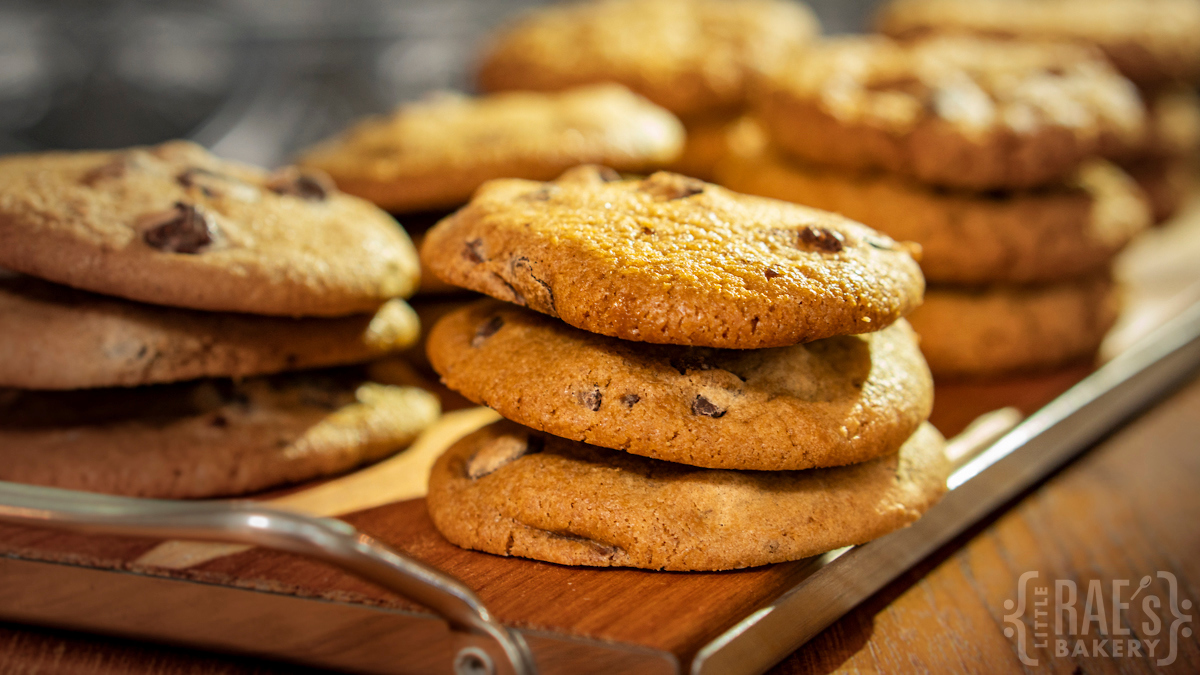
Brown sugar and white sugar are used in our chocolate chip cookies for added chewiness and flavor.
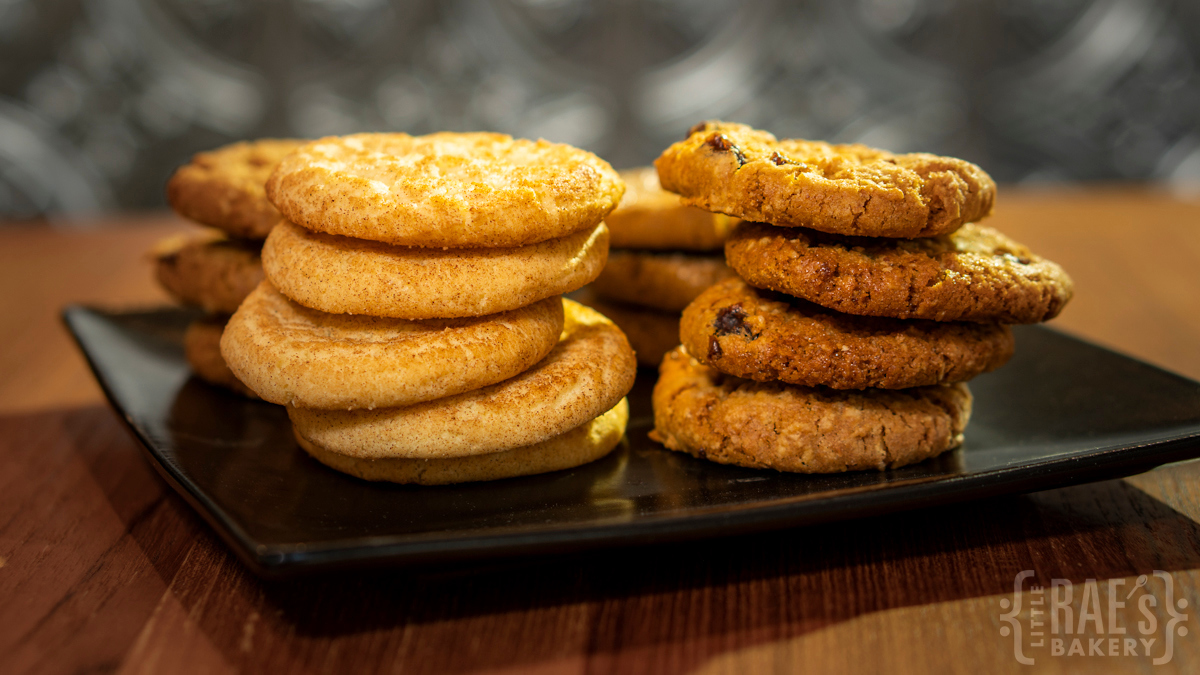
To get an extra caramelly flavor and maximum chewiness, we use only brown sugar in our oatmeal raisin cookies.
Comparing Sugars: Processing, Crystal Size, and Color
Wondering how all these sugars stack up against one another? We’ve compressed the information above into a handy graphic that shows you how these sugars compare in terms of the level of processing, average crystal size, and color. We hope this graphic will come in handy the next time you’re experimenting with recipes or need to make a quick sugar swap!
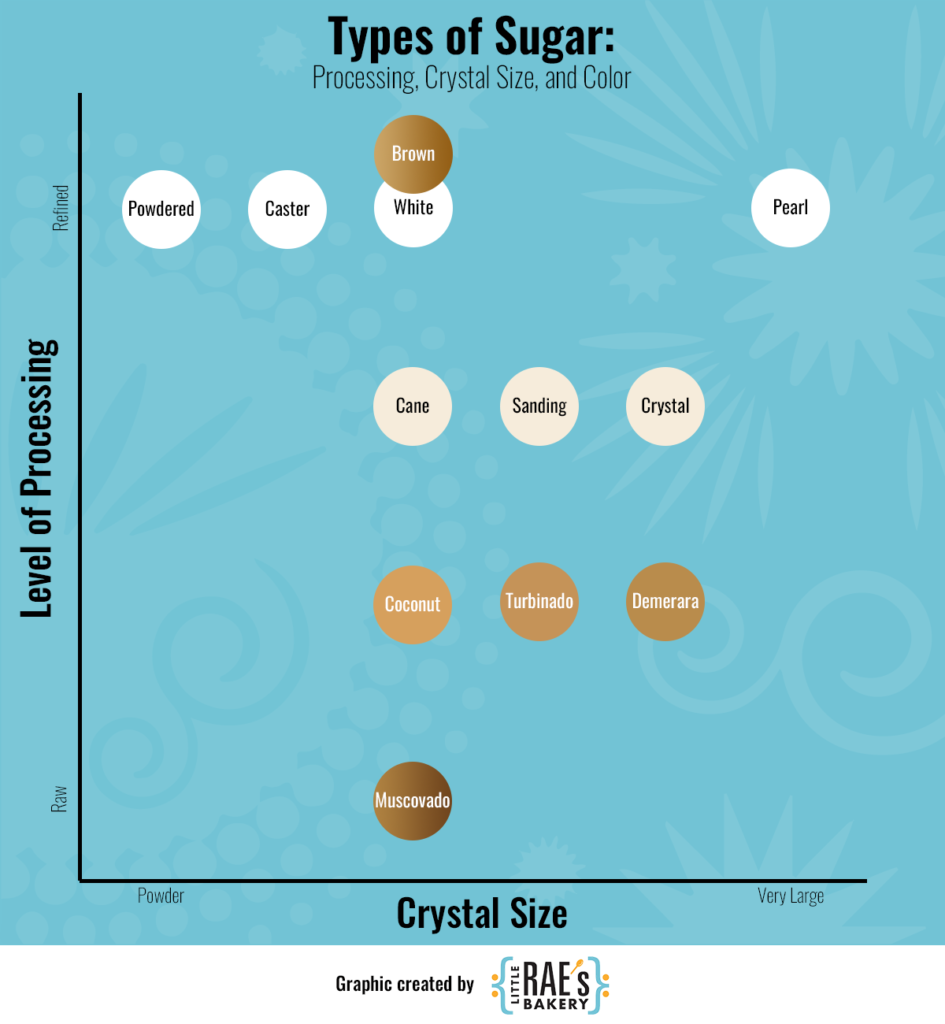
With that, we’re wrapping up this blog series. Don’t forget to check out Part 1: The Fats and Part 2: The Flours if you missed them! We hope this series has helped you develop a deeper understanding of how ingredients interact with each other and what to consider when either developing your own recipes or modifying your favorites.
If we could leave you with just one piece of advice, it’s this: have fun! Your kitchen can be a great playground, and experimentation is encouraged. Things might not always turn out the way you expect them to, but the experience, knowledge, and—yes—fun, make it all worth it in the end.

